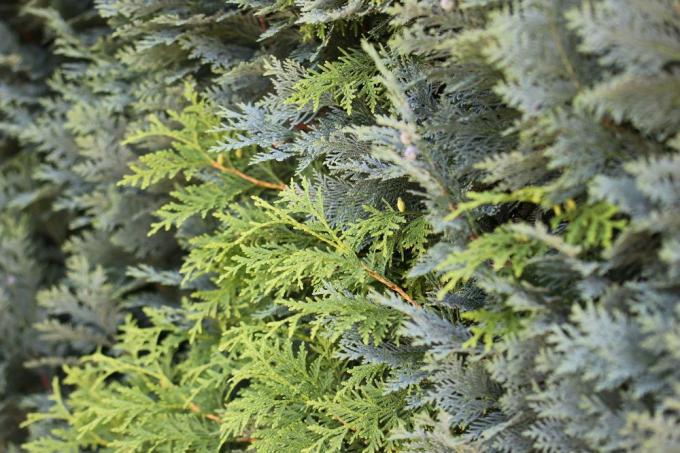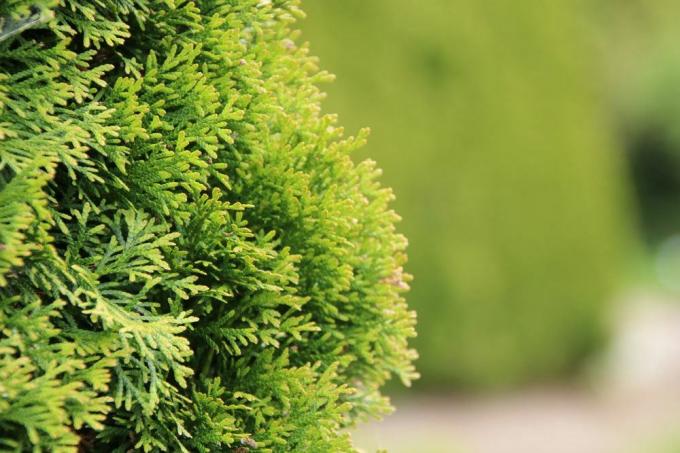
table of contents
- Thuja emerald plant
- Prepare the planting area
- Planting thuja emerald - instructions
- Plant spacing
- Inside hedges and in solitary positions
- Too busy roads
- To neighboring properties
- Planting time
- Avoid transplanting if possible
The Thuja occidentalis 'Smaragd' is a comparatively slow-growing wood. In contrast to other thujas, this one has a slender, conical, very dense and highly branched habit. It is absolutely opaque even without a cut. As a result, it is just as suitable for creating a view, noise or windbreak hedge as it is for a solitary position. It also sets high-contrast accents as a background plant. The foundation stone for optimal growth is laid as soon as the plants are planted.
Thuja emerald plant
Before you can plant, you need to find the right location. This can be sunny or partially shaded, whereby the intense green color is best shown in a sunny spot. In complete shade, however, the leaf color can suffer. Locations with frequent cold winds should also be avoided as far as possible.
In addition to a sunny location, the Thuja Smaragd needs a loose, slightly humus-rich, moist but not too wet and only minimally acidic soil. It should be able to store water well. On permanently dry soil, the needles would soon turn brown.
Prepare the planting area
Planting one or more thuja requires some preparation. This applies in particular to the soil in the planting area.
- Thoroughly loosen the soil
- From all weeds, root remains, stones, etc. to free
- Depending on the nature of the soil, work in some fertilizer
- Preferably some mature manure, compost or horn shavings
- Make heavy clay soils more permeable by adding sand
- Improve soils that are too damp by creating a drainage system
- When planting a hedge, first mark the course
- Mark the area with stakes and a string
- Cord should serve as a guide
- Must be absolutely level
- Then dig plant holes or a continuous trench
- Loosen the bottom of the trench or holes well
tip: When dealing with the tree of life one should take into account that the Thuja is highly poisonous is for humans and animals.
Planting thuja emerald - instructions
- Place in the prepared planting holes with sufficient distance
- Always plant bare roots immediately after purchase
- Take container goods out of the pot and insert
- Just as deep into the earth as they were in the pot before
- Root balls of so-called bale goods wrapped in a ball cloth or net
- Open both, strip down about a third or cut into several times
- Should prevent it from growing into the root
- Material rots in the earth over time
- After the plants have been set, fill the planting pit with soil
- Then carefully step on the earth
- In the last step, water the whole thing well
- It is best to wash in the root area
- After flooding in, cover with a layer of bark mulch
- Mulch prevents the soil from drying out too much
- Maintain regular watering in the following months as well
tip: So that no cavities form between the roots, it makes sense when filling up the planting holes, especially with bare-root specimens, to shake them slightly again and again. A watering edge that is placed around the plants prevents water from flowing away.
Plant spacing
The best possible site conditions are of course of no use if you do not pay attention to sufficient plant spacing, both among each other z. B. in a hedge, as well as to other plants, paths, roads and neighboring properties. Even if the thuja emerald does not want to grow properly, this may be due to the fact that the distances are too short, although they are comparatively narrow with a growth width of 0.5 to 0.8 m after about ten years remain. But how much space should you leave between the plants?
Inside hedges and in solitary positions
The distance between the thuja plants within a hedge should be about 60-80 cm. You count two to two and a half plants per meter. If you want to achieve good opacity as quickly as possible, you can choose a smaller distance. However, the lower the planting distance, the more time-consuming it is to maintain it.
Planting that is too dense also prevents the air from circulating properly and prevents sufficient sunlight from reaching the lower parts of the tree. Hence the branches become brown and bald. In addition, there is competition among each other when it comes to the supply of nutrients. In the case of a solitaire or This is less of a problem for individual positions, distances of approx. 100 cm from neighboring plants is recommended.
Too busy roads
Arborvitae are shallow roots, i.e. their roots run close to the surface of the earth. It can happen that they lift and damage sidewalk or terrace slabs, paving stones and even road surfaces if the distance to the thuja is too small. In order to avoid damaging paths and terraces, the Thuja Smaragd should be planted with a spacing that corresponds approximately to the height of the tree.
It is a little more difficult on busy roads, because the tree of life is very sensitive to road salt, polluted spray water and exhaust gases. It is best to do without the thuja in the immediate vicinity of a street and opt for another, more suitable type of hedge plants.
To neighboring properties
Border planting is always a sensitive issue and can quickly lead to disputes among neighbors, which could actually be easily avoided. In addition, a sufficiently large distance can make it much easier to care for the plants. Corresponding regulations in this regard are anchored in the neighborhood law of the individual federal states and are regulated by the responsible municipalities. For hedges with a height of over 200 cm, a distance of 100 cm to the neighboring property is sufficient in most cases. In general, they depend on the final height and width of the respective wood.
tip: Anyone who is not sure about the observance of the planting distances to neighboring properties can find out more from the responsible authority.
Planting time
- Thuja emerald can be planted all year round
- As long as the soil is frost-free and there is no other frost
- The best time to plant is in spring
- Especially in April and May
- Root formation is best at this time of year
- If the right time was missed, planting is also possible in early autumn
- Should be completed by the beginning of October at the latest
- Plants should have time to grow before the onset of the first frost
But not only the season is decisive, but also the weather on and after the day of planting. So you should wait with planting if frost is expected, as well as during a prolonged period of rain and when it is very hot.
tip: When planting in autumn, it is advisable to protect the sensitive root area from frost with a thick layer of mulch. The aboveground parts of young plants need protection from intense sunlight.
Avoid transplanting if possible
The choice of the location for the Thuja Smaragd should be carefully considered because it does not like transplanting. If the plants are still relatively young, they can still be moved if necessary. It is not recommended for older specimens, as they usually grow very poorly or not at all and, in the worst case, die. This is mainly due to the pronounced roots that can hardly be excavated without major damage. Should it still be unavoidable, spring is the best time here too. You should make sure that the new planting hole is big enough that the roots can develop well.
When digging up, the soil is cut up to a meter around the trunk, depending on the size of the plant, and this area is largely exposed. With a digging fork you try to lift the root ball and pull the thuja out of the earth without damaging the roots too much. If the plant is then in the new location, it is important, depending on the weather, to water it thoroughly every day for several weeks.
tip: If the plants have to survive a longer transport after being excavated, it is important to protect the root ball from drying out. You can do that by wrapping it in damp burlap with enough soil and planting it back as soon as possible.


